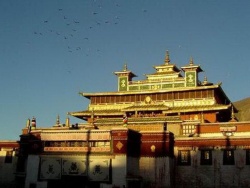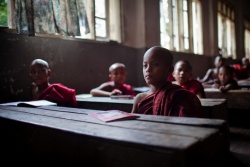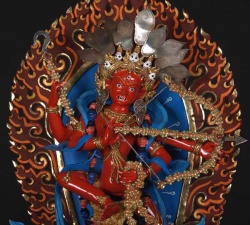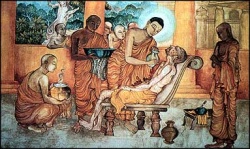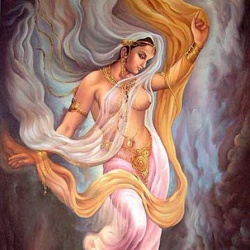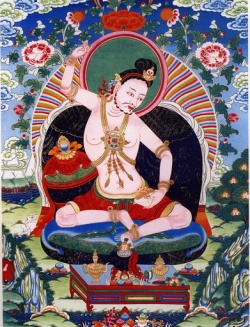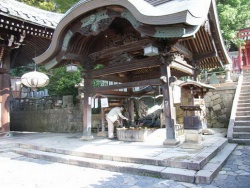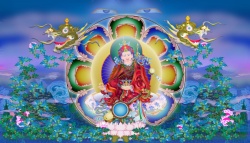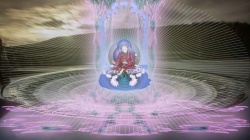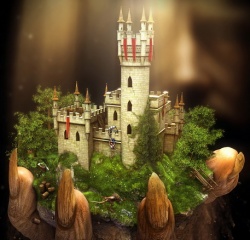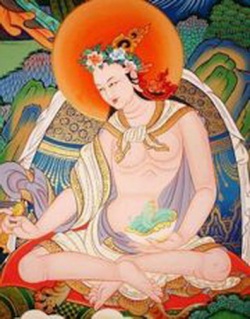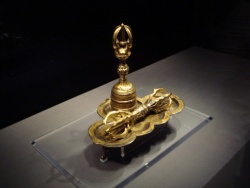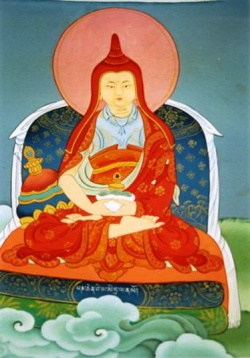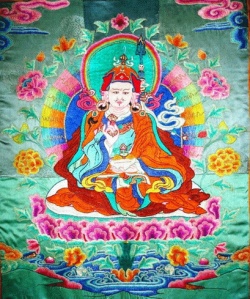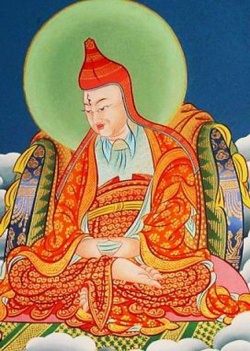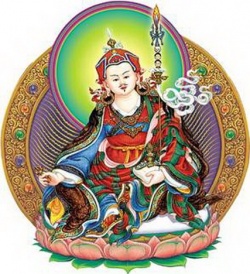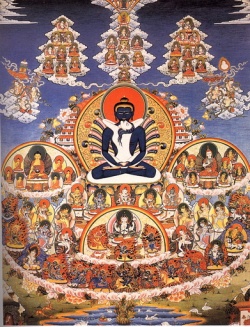Difference between revisions of "The Nyingma Tradition, the old Secret Tantra"
m (Text replacement - "Central Asia" to "{{Wiki|Central Asia}}") |
m (Text replacement - "birthplace " to "birthplace ") |
||
| (10 intermediate revisions by 3 users not shown) | |||
| Line 1: | Line 1: | ||
| − | [[File:Samye-mon.jpg|thumb|250px|]] | + | [[File:Samye-mon.jpg|thumb|250px|]]<nomobile>{{DisplayImages|2745|61|829|969|449|928|784|4125|4571|3895}}</nomobile> |
| + | |||
| + | |||
| + | |||
| + | |||
| + | |||
| + | |||
| + | |||
| + | <poem> | ||
| + | "The [[Nyingma Tradition]], the old [[Secret Tantra]], classifies the [[Buddha's Dharma]] into [[nine successive Vehicles]], collectively contained in the [[Cause Vehicle]] and the [[Result Vehicle of Tantra]]. | ||
| + | |||
| + | |||
| + | The [[Cause Vehicle]] has [[three divisions]]: | ||
| + | |||
<poem> | <poem> | ||
| − | + | the [[Hinayana Vehicle]] of the [[Sravakas]], | |
| + | the [[Hinayana]] [[Vehicle]] of [[Pratyekabuddhas]] and | ||
| + | the [[Mahayana]] [[Vehicle of the Bodhisattvas]]. | ||
| + | </poem> | ||
| − | |||
| − | |||
| − | + | In the [[Result Vehicle]] of [[Tantra]] there are two divisions: | |
| − | + | <poem> | |
| + | the three [[Outer Tantric Vehicles]], and | ||
| + | the three great methods of the [[Inner Tantric Class]]. | ||
| + | </poem> | ||
| − | + | All these have a great many definitions and explanations concerning their view, [[meditation]], [[action]] and result, but it is not possible to write these explanations here. | |
| − | |||
| − | "The Nyingma Tradition, the old Secret Tantra, classifies the Buddha's Dharma into nine | + | |
| + | There are [[three lineages]] in the old translations of the [[Nyingma Tantras]]: | ||
| + | |||
| + | |||
| + | the '[[Distant Oral Lineage]]' ([[Tibetan]]: [[Ring.rGyud.bKah.ma]] - from the [[direct oral teachings of the Buddha]]); | ||
| + | |||
| + | the '[[Near Treasure Lineage]]' (Tib: [[Nye.rGud.gTer.ma]] - from teachings of discovered [[treasure texts]], written and concealed in [[holy places]] by [[Guru Rinpoche]], [[Khandro Yeshe Tsogyal]] and others; | ||
| + | |||
| + | |||
| + | |||
| + | for the [[benefit]] of {{Wiki|future}} generations), and the '[[Lineage of Profound Pure Visions]]' (Tib: [[Zab.mo.dag.sNang]] - from teachings received by various [[Saints]] during [[visions]] in [[meditation]] and [[post-meditation]])." | ||
| + | |||
| + | |||
| + | (Excerpt from the [[Opening of the Dharma]], A Brief Explanation of the [[Essence]] of the Limitless Vehicles of the [[Buddha]]. | ||
| + | |||
| + | Written by [[Dzongsar Jamyang Khyentse Chokyi Lodro]]. | ||
| + | |||
| + | Translated by [[Dzongsar Jamyang Khyentse]] [[Chokyi Gyatso]], {{Wiki|Malaysia}}, October 1984). | ||
| + | |||
| + | |||
| + | |||
| + | ==[[Nyingma Tradition]]== | ||
| + | |||
| + | |||
| + | |||
| + | |||
| + | [[Six Mother Monasteries]]: | ||
| + | |||
| + | <poem> | ||
| + | [[Katog Dorje Den]] (1159) | ||
| + | [[Tubten Dorje Drag]] (1632) | ||
| + | [[Palyul Namgyal Jangchub Ling]] (1665) | ||
| + | [[Urgyan Mindroling]] (1676) | ||
| + | [[Dzogchen Urgyan Samten Choling]] (1685) | ||
| + | [[Shechen Tennyi Dargye Ling]] (1735) | ||
| + | </poem> | ||
| + | |||
| + | (An earlier inclusion in place of [[Shechen Monastery]] was [[Chongye Palri Tegchog Ling]]. | ||
| + | |||
| + | [[Dodrubchen Monastery]] is sometimes substituted for [[Katog]]. [ | ||
| + | |||
| + | [Samye Monastery]] was the [[first monastery in Tibet]] established by [[King Trisong Detsen]] and [[Shantirakshita]] with the help of [[Padmasambhava]]). | ||
| + | |||
| + | |||
| + | |||
| + | ==The [[Nyingma Tradition]]== | ||
| + | |||
| + | |||
| + | |||
| + | "The [[Nyingma Tradition]], the old [[Secret Tantra]], classifies the [[Buddha's Dharma]] into [[nine Vehicles]], collectively contained in the [[Cause Vehicle]] and the [[Result Vehicle of Tantra]]. | ||
| + | |||
| + | The [[Cause Vehicle]] has [[three divisions]]: the [[Hinayana Vehicle]] of the [[Sravakas]], the [[Hinayana Vehicle]] of [[Pratyekabuddhas]] and the [[Mahayana Vehicle of the Bodhisattvas]]. | ||
| + | |||
| + | <poem> | ||
| + | In the [[Result Vehicle of Tantra]] there are two divisions: | ||
| + | |||
| + | the [[three Outer Tantric Vehicles]], and | ||
| + | the three great methods of the [[Inner Tantric Class]]. | ||
| + | </poem> | ||
| + | |||
| + | All these have a great many definitions and explanations concerning their view, [[meditation]], [[action]] and result, but it is not possible to write these explanations here. | ||
| + | |||
[[File:Yeshe Tsogyal110.JPG|thumb|250px|]] | [[File:Yeshe Tsogyal110.JPG|thumb|250px|]] | ||
| − | |||
| − | |||
| − | Nyingma History of the Early Propagation of Buddhism to Tibet | + | ==[[Nyingma History]] of the [[Early Propagation of Buddhism to Tibet]]== |
| − | Advent of Buddhism in Tibet | + | |
| + | |||
| + | |||
| + | ===[[Advent of Buddhism in Tibet]]=== | ||
| + | |||
| + | |||
| + | Central [[Tibet's]] earliest exposure to [[Buddhism]] is ascribed to the reign of the twenty-eighth [[king]] [[Lha Totori Nyentsen]] ([[lha tho tho ri gnyan btsan]]; 374-493), although there may have been even earlier contacts in the [[Sino-Tibetan]] borderlands. | ||
| − | + | However, the formal introduction of the [[Buddhist teachings]] coincided with the [[nine great religious kings]] who forged an [[empire]] in {{Wiki|Central Asia}} between 629 and 848. | |
[[File:Vajra2.JPG|thumb|250px|]] | [[File:Vajra2.JPG|thumb|250px|]] | ||
| − | |||
| − | + | Some [[Buddhist texts]] were translated into [[Tibetan]] from {{Wiki|Chinese}}, {{Wiki|Khotanese}}, and [[Burushaski]], but the vast majority of translations were made from [[Sanskrit]] sources, in two {{Wiki|distinct}} phases, that are demarcated by the implosion of the [[Tibetan empire]] during the ninth century. | |
| + | |||
| + | The [[Nyingma tradition]] maintains the [[teaching]] cycles and texts that were introduced during the earlier dissemination, or [[ngadar]] ([[snga dar]]) at the height of [[Tibet's]] {{Wiki|imperial}} power. | ||
| − | Popular legends alternatively assert that these sutras along with the dharani of the Wish-Fulfilling Gem, dedicated to Tibet's patron deity Avalokiteshvara, a mould engraved with the six-syllable mantra of Avalokiteshvara, and a golden stupa, all mysteriously landed on the palace roof at Yumbu Lagang (yum bu bla sgang). These objects were consequently given the name 'awesome secret' (gnyan po gsang ba) and were concealed because no one could understand their meaning. The king obtained a prophesy to the effect that the meaning of the awesome secret would be disclosed after five generations, | + | |
| + | This is in contrast to the various so-called new, or | ||
| + | |||
| + | <poem> | ||
| + | [[sarma]] ([[gsar ma]]) schools | ||
| + | |||
| + | ([[Kadam]], | ||
| + | [[Kagyu]], | ||
| + | [[Gelug]], | ||
| + | </poem> | ||
| + | |||
| + | etc) that adhere to texts and teachings that were introduced during the later phase of dissemination, or [[chidar]] ([[phyi dar]]), from the late tenth century onward. | ||
| + | |||
| + | An even narrower line of demarcation between the early and later phases of translation is sometimes drawn between the [[lifetime]] of the [[Indian]] [[scholar]] [[Smotijnanakirti]] (early tenth century) and that of the [[Tibetan translator]] [[Rinchen Zangpo]] ([[rin chen bzang po]]). | ||
| + | |||
| + | |||
| + | One sober account, written by the thirteenth-century historian [[Nelpa Pandita Dragpa Monlam Lodro]] ([[nel pa paNDi ta grags pa smon lam blo gros]]), asserts that around 433 CE certain [[Buddhist texts]], [[including]] the [[Karandavyuhasutra]] and a text recorded under multiple names, [[including]] [[Pankyong Chagyapa]] ([[spang skong phyag brgya pa]]), | ||
| + | |||
| + | were brought to [[Tibet]] by the [[masters]] [[Buddharaksita]] and [[Tilise]] from [[wikipedia:Khotan|Khotan]]. | ||
| + | |||
| + | At that time, [[wikipedia:Khotan|Khotan]] was already an important oasis and crossroads for [[Buddhist teachers]] moving between [[India]] and [[China]]. [[Nelpa Pandita]] recounts how they returned to [[wikipedia:Khotan|Khotan]] having discovered that no one could read or understand the meaning of the [[books]]. | ||
| + | |||
| + | |||
| + | Popular {{Wiki|legends}} alternatively assert that these [[sutras]] along with the [[dharani]] of the [[Wish-Fulfilling Gem]], dedicated to [[Tibet's patron deity]] [[Avalokiteshvara]], a mould engraved with the [[six-syllable mantra]] of [[Avalokiteshvara]], | ||
| + | |||
| + | and a golden [[stupa]], all mysteriously landed on the palace roof at [[Yumbu Lagang]] ([[yum bu bla sgang]]). | ||
| + | |||
| + | These [[objects]] were consequently given the [[name]] 'awesome secret' ([[gnyan po gsang ba]]) and were concealed because no one could understand their meaning. The [[king]] obtained a [[prophesy]] to the effect that the meaning of the awesome secret would be disclosed after five generations, a | ||
| + | |||
| + | nd as an [[auspicious]] coincidence he was rejuvenated, living to the ripe [[old age]] of 120. His tomb is said to be at [[Dartang]] near the [[Chongye]] [[River]], though others say he vanished into [[space]]. | ||
[[File:Vimalamitrab12.JPG|thumb|250px|]] | [[File:Vimalamitrab12.JPG|thumb|250px|]] | ||
| − | |||
| − | It appears from other sources, such as Faxian's records of Buddhism in {{Wiki|Central Asia}} (dated 400 CE), that Lha Totori's discovery of Buddhism was probably predated by Buddhist contacts in northeast Tibet, where the Tibetan Pu / Fu family formed the ruling house during the Earlier Qin Dynasty (351-394). The secessionist Later Qin Dynasty (384-417) is said to have offered patronage to the renowned Buddhist scholar Kumarajiva, and its rulers were well acquainted with the Buddhist teachings. | + | The extant [[Tibetan]] translation of the [[Karandavyuhasutra]] is attributed to the [[scholars]] [[Jinamitra]] and [[Danashila]], working with the [[translator]] [[Yeshe De]] ([[ye shes sde]]) during the early ninth century. |
| + | |||
| + | The [[Tibetan]] version of the [[Pankyong Chagyapa]] is attributed to [[Tonmi Sambhota]] ([[Thon mi sambhota]]), in the seventh century. | ||
| + | |||
| + | |||
| + | It appears from other sources, such as [[Faxian's]] records of [[Buddhism]] in {{Wiki|Central Asia}} (dated 400 CE), that [[Lha Totori's]] discovery of [[Buddhism]] was probably predated by [[Buddhist]] contacts in [[northeast]] [[Tibet]], where the [[Tibetan]] Pu / [[Fu family]] formed the ruling house during the Earlier {{Wiki|Qin Dynasty}} (351-394). | ||
| + | |||
| + | The secessionist Later {{Wiki|Qin Dynasty}} (384-417) is said to have [[offered]] {{Wiki|patronage}} to the renowned [[Buddhist scholar]] [[Kumarajiva]], and its rulers were well acquainted with the [[Buddhist teachings]]. | ||
| + | |||
| + | |||
| + | ==The [[Era of the Religious Kings]]== | ||
| + | |||
| + | |||
| + | The thirty-third [[king]], [[Songtsen Gampo]] ([[srong btsan sgam po]]), acceded to the [[throne]] in 629. | ||
| + | |||
| + | He conquered the far-western {{Wiki|kingdom}} of [[Zhangzhung]] and successfully unified the whole of [[Tibet]] for the first time in its recorded history. | ||
| + | |||
| + | [[Songtsen Gampo]] campaigned against the [[Azha T'u yu-un]], an Altaic [[people]] who then inhabited the [[Amdo]] area of [[northeast]] [[Tibet]], and skillfully reabsorbed the [[Sumpa]] pastoralists of the extreme [[northeast]] within the fold of the [[Tibetan empire]]. | ||
| + | |||
| + | Then, following the [[Sui]] [[Emperor's]] {{Wiki|annihilation}} of the [[Azha]] around 630, the [[Tibetans]] (known in {{Wiki|Chinese}} sources as [[Tubo]]) expanded into the northeastern borderlands to fill the {{Wiki|vacuum}}, routing the remnants of the [[Azha]] as they went. | ||
| − | + | Direct [[contact]] with [[Wikipedia:Tang dynasty|Tang China]] was thereby established around 638. | |
| − | + | [[Lhasa]] became the capital of this unified [[Tibetan empire]], and the original [[Potala Palace]] was [[constructed]] as the king's foremost residence. | |
| − | + | In the course of establishing his [[empire]] [[Songtsen Gampo]] came into [[contact]] with the [[Buddhist traditions]] of [[India]], [[wikipedia:Khotan|Khotan]], and [[China]], and quickly immersed himself in [[spiritual]] pursuits, reportedly under the influence of his foreign queens. | |
[[File:TibChakra.jpg|thumb|250px|]] | [[File:TibChakra.jpg|thumb|250px|]] | ||
| − | |||
| − | + | According to some [[Tibetan]] sources the [[king]] abdicated in favor of his son [[Gungsong Gungtsen]] ([[gung srong gung btsan]]), but when the [[latter]] predeceased his father in 646, he resumed the [[throne]]. | |
| − | + | [[Tibetan]] influence during this period extended into [[Nepal]] and [[India]], enabling the [[king]], according to [[Tibetan]] legend, to send his able [[minister]] [[Tonmi Sambhota]] to [[India]], where the [[uchen]] ([[dbu chen]]) [[script]] was developed from an [[Indian]] prototype to represent the [[Tibetan language]]. | |
| − | + | Internally he developed a legal code which was highly respected throughout the [[Tibetan]] [[world]]. | |
| − | Tibetan geomantic temples were laid out, following an ancient Chinese model, according to four zones of imperial influence, corresponding to the central government, the royal domain, the zone of pacification, and the periphery of allied barbarians. | + | Toward the end of his [[life]] the [[king]] abdicated a second time, in favor of his grandson Mangtsong Mangtsen. He passed his final years in [[spiritual]] [[retreat]]. |
| + | |||
| + | In the course of establishing his [[empire]], [[Songtsen Gampo]] came into [[contact]] with the [[Buddhist traditions]] of [[India]], [[wikipedia:Khotan|Khotan]], and [[China]]. He quickly immersed himself in [[spiritual]] pursuits, reportedly under the influence of his foreign queens [[Bhrikuti]], the daughter of {{Wiki|Amshuvarman}}, [[king]] of [[Nepal]], and [[Wencheng]], daughter of [[Tang Taizong]], [[Emperor of China]]. | ||
| + | |||
| + | These queens are said to have brought as their dowry the two foremost images of [[Buddha Shakyamuni]]. The one that [[Bhrikuti]] introduced from [[Nepal]] was in the [[form]] of [[Aksobhya]]. | ||
| + | |||
| + | The other one, in the [[bodhisattva]] [[form]] known as [[Jowo Rinpoche]] ([[jo bo rin po che]]), was introduced from [[China]]. | ||
| + | |||
| + | Moreover, when [[Princess Wencheng]] arrived in [[Tibet]], she is said to have introduced {{Wiki|Chinese}} {{Wiki|divination}} texts, [[including]] the so-called [[Portang scrolls]], and she encouraged the [[king]] [[to build]] [[geomantic]] [[temples]] at important power-places across the length and breadth of the land. | ||
| + | |||
| + | These are revered as the earliest [[Buddhist temples]] of [[Tibet]]. | ||
| + | |||
| + | [[Tibetan]] [[geomantic]] [[temples]] were laid out, following an [[ancient]] {{Wiki|Chinese}} model, according to four zones of {{Wiki|imperial}} influence, [[corresponding]] to the central government, the {{Wiki|royal}} domain, the zone of pacification, and the {{Wiki|periphery}} of allied [[barbarians]]. | ||
[[File:Ugyen-guru-padmasambhava.JPG|thumb|250px|]] | [[File:Ugyen-guru-padmasambhava.JPG|thumb|250px|]] | ||
| − | |||
| − | + | Just as [[China]] was [[conceived]] of as a supine [[turtle]], so the [[Tibetan]] terrain was seen as a supine ogress, and [[geomantic]] [[temples]] were to be [[constructed]] at focal points on her [[body]]: | |
| + | |||
| + | the [[Jokhang]] ([[jo khang]]) at the [[heart]], the four '[[district controlling]]' [[temples]] on her shoulders and hips, the four '[[border taming]]' [[temples]] on her elbows and knees, and the four 'further taming' [[temples]] on her hands and feet. | ||
| − | Trisong Detsen (khri srong lde'u btsan), the thirty-eighth king (r. 755-797), built a royal temple near his own birthplace at Drinzang (mgrin bzang), shortly before his construction of Samye Monastery. Mune Tsenpo (mu ne btsan po; r. 797-804), the thirty-ninth king, established the temple of Karchung at Ramagang (skar chung ra ma sgang), near Lhasa, and Ralpachen (ral pa can; r. 815-841), the forty-first king, followed his example at Onchangdo Pemei Tashi Gephel ( | + | |
| + | Some chronicles report that the actual number of [[temples]] [[constructed]] at this early period exceeded one hundred, but most sources confine themselves to thirteen. | ||
| + | |||
| + | The immediate successors of [[Songtsen Gampo]] are said to have continued [[to build]] [[Buddhist temples]], many of them [[including]] a central image of the [[Buddha Vairocana]]. | ||
| + | |||
| + | Among them, [[Dusong Mangpoje]] ('[[du srong mang po rje]]; 676-704), the thirty-sixth [[king]], is credited with the building of a [[temple]] at Ling in [[Eastern Tibet]]. | ||
| + | |||
| + | [[Tride Tsugten]] ([[khri lde gtsug brtsan]]; r. 705-755), the thirty-seventh [[king]], built the [[temple]] of [[Drakmar Keru]], which can still be visited today in the On ('on) valley, [[north]] of [[Tsetang]] ([[rtses thang]]). | ||
| + | |||
| + | His {{Wiki|Chinese}} [[consort]], {{Wiki|princess}} [[Jincheng]], is said to have established a short-lived {{Wiki|community}} of {{Wiki|Khotanese}} [[monks]] in {{Wiki|Central Tibet}}, prior to her [[death]] in 739. [[King]] [[Tride Tsugten]] also [[married]] [[Nanamza]], a {{Wiki|princess}} of [[Tibetan]] {{Wiki|aristocratic}} background, who gave [[birth]] to his son and heir in 730. | ||
| + | |||
| + | [[Jincheng]] passed away in 739 when the bubonic plague devastated [[Tibet]], and this, coinciding with conflict on the {{Wiki|Silk Road}}s, seems to have provoked an anti-Buddhist rebellion in [[Lhasa]]. | ||
| + | |||
| + | The [[king]] was assassinated by discontented ministers in 755. | ||
| + | |||
| + | |||
| + | [[Trisong Detsen]] ([[khri srong lde'u btsan]]), the thirty-eighth [[king]] (r. 755-797), built a {{Wiki|royal}} [[temple]] near his [[own]] birthplace at [[Drinzang]] ([[mgrin bzang]]), shortly before his construction of [[Samye Monastery]]. | ||
| + | |||
| + | [[Mune Tsenpo]] ([[mu ne btsan po]]; r. 797-804), the thirty-ninth [[king]], established the [[temple]] of [[Karchung]] at [[Ramagang]] ([[skar chung ra ma sgang]]), near [[Lhasa]], and [[Ralpachen]] ([[ral pa can]]; r. 815-841), the forty-first [[king]], followed his example at [[Onchangdo Pemei Tashi Gephel]] ([[on cang do pad+ma'i bkra shis dge 'phel]]), where he established a committee of [[translators]], in order to standardize the [[Buddhist]] {{Wiki|terminology}} of the [[Tibetan language]]. | ||
[[File:Vairotsana4456.JPG|thumb|250px|]]G | [[File:Vairotsana4456.JPG|thumb|250px|]]G | ||
| − | |||
| − | + | Following the [[death]] of his father, [[Langdarma Udumtsen]] ([[glang dar ma u dum btsan]]), {{Wiki|Prince}} [[Namde Osung]] ([[gnam lde 'od srung]]) revived this [[tradition]] of [[temple]] building at Jasa near [[Tsetang]]. | |
| − | + | There are several extant sites in [[Eastern Tibet]] - in [[Drayab]] ([[brag g.yab]]), [[Jyekundo]] ([[skye rgu mdo]]), [[Sershul]] and [[Minyag]], among others - that attest to the final days of {{Wiki|imperial}} {{Wiki|patronage}} of the great [[religious kings]] of [[Tibet]]. | |
| − | In order to establish monasticism in Tibet and pave the way for Buddhist civilization within his empire, King Trisong Detsen invited the Indian preceptor Shantarakshita to expound the teachings of the causal vehicles in Tibet and found a monastery at Samye, possibly in the year 779. He establishment of Buddhism as the state religion of Tibet, commemorated by an inscribed pillar at the entrance to Samye Monastery, was a threshold of enormous significance, in that the eclipse of Bon and the gradual demilitarization of the Tibetan world can be traced back to that event. When their objective was thwarted by obstacles instigated by hostile non-Buddhist forces, the king was advised by Shantarakshita to invite the ritual specialist Padmasambhava to participate in this endeavor. According to Nyingma tradition, it was Padmasambhava's subjugation of the indigenous local demons on Mount Hepori that paved the way for the establishment of Buddhist monasticism in Tibet. | + | |
| + | ==[[Buddhist Monasticism]]== | ||
| + | |||
| + | |||
| + | [[King]] [[Tride Tsugten's]] successor, [[Trisong Detsen]], was perhaps the greatest of all the [[Tibetan kings]], and it was during his reign (755-797) that [[Buddhism]] was formally established as the [[state religion]]. | ||
| + | |||
| + | His early years were characterized by {{Wiki|military}} campaigns against [[Wikipedia:Tang dynasty|Tang China]]. | ||
| + | |||
| + | The [[Tibetan]] {{Wiki|army}} occupied the {{Wiki|imperial}} capital [[Xi'an]] in 763, and the [[Zhol pillar]] was erected at [[Lhasa]] to commemorate this event. Increasingly, the [[king]] sought to promote [[Buddhism]], which [[offered]] [[Tibet]] a system of [[universal]] [[ethical]] laws and [[spiritual]] values, and supported a rich core of {{Wiki|learning}} in the classical {{Wiki|sciences}}. | ||
| + | |||
| + | In order to establish [[monasticism]] in [[Tibet]] and pave the way for [[Buddhist]] {{Wiki|civilization}} within his [[empire]], [[King Trisong Detsen]] invited the [[Indian]] [[preceptor]] [[Shantarakshita]] to expound the teachings of the [[causal vehicles]] in [[Tibet]] and found a [[monastery]] at [[Samye]], possibly in the year 779. | ||
| + | |||
| + | He establishment of [[Buddhism]] as the [[state religion]] of [[Tibet]], commemorated by an inscribed pillar at the entrance to [[Samye Monastery]], was a threshold of enormous significance, in that the [[eclipse]] of [[Bon]] and the [[gradual]] demilitarization of the [[Tibetan]] [[world]] can be traced back to that event. | ||
| + | |||
| + | When their [[objective]] was thwarted by [[obstacles]] instigated by {{Wiki|hostile}} [[non-Buddhist]] forces, the [[king]] was advised by [[Shantarakshita]] to invite the [[ritual]] specialist [[Padmasambhava]] to participate in this endeavor. | ||
| + | |||
| + | According to [[Nyingma tradition]], it was [[Padmasambhava's]] subjugation of the indigenous local {{Wiki|demons}} on Mount [[Hepori]] that paved the way for the establishment of [[Buddhist monasticism]] in [[Tibet]]. | ||
[[File:Sa02.jpg|thumb|250px|]] | [[File:Sa02.jpg|thumb|250px|]] | ||
| − | |||
| − | + | [[King Trisong Detsen]], at [[Shantaraksita's]] suggestion, ensured that the complex was modeled on the plan of [[Odantapuri Monastery]], where the buildings themselves represented the [[Buddhist]] [[cosmological]] order, with [[Mount Sumeru]] in the centre, surrounded by [[four continents]] and [[eight subcontinents]], {{Wiki|sun}} and [[moon]], all within a perimeter wall known as the [[Chakravala]]. | |
| − | + | This construction would therefore come to [[symbolize]] the establishment of a new [[Buddhist]] [[world]] order in [[Tibet]]. | |
| − | In 792, Samye was the setting for a grand debate held between Kamalashila, an Indian proponent of the graduated path to buddhahood, which emphasizes the performance of virtuous actions, and the Chinese monk (Hoshang) Mohoyen, a proponent of the instantaneous path to buddhahood, with its emphasis on meditation and inaction. Mohoyen was invited down from Dunhuang, which the Tibetans had recently conquered. According to most histories, Kamalashila emerged as the victor. However, according to other historians, such as Nubchen Sanggye Yeshe (gnubs chen sangs rgyas ye shes) and Nyangral Nyima Oser (nyang ral nyi ma 'od zer), the Chinese side was declared the superior teaching, albeit one that was unsuitable for Tibetans. | + | {{Wiki|Legends}} recount how [[humans]] were engaged in this unprecedented building project by day and [[spirits]] by night. |
| + | |||
| + | Hence the [[monastery's]] full [[name]]: [[Glorious Inconceivable Temple of Unchanging Spontaneous Presence]] ([[dpal bsam yas mi 'gyur lhun grub gtsug lha khang]]). | ||
| + | |||
| + | |||
| + | [[Shantaraksita]] was requested to preside over the [[ordination]] of [[Tibet's]] first seven [[monks]], the so-called [[seven men who were tested]] ([[sad mi mi bdun]]), namely: | ||
| + | |||
| + | [[Ba Trizhi]] ([[rba khri gzigs]]), also known as [[Nanam Dorje Dudjom]] ([[sna nam rdo rje bdud 'joms]]); | ||
| + | |||
| + | [[Ba Selnang]] ([[sba gsal snang]]), [[Pagor Vairocana]], [[Ngenlam Gyelwa Choyang]] ([[rgyal ba mchog dbyangs]]), [[Khon Lui Wangpo Sungwa]] ('[[khon klu'i dbang po srung ba]]), [[Ma Rinchen Chog]] ([[rma rin chen mchog]]), and [[Lasum Gyalwa Jangchub]] ([[la gsum rgyal ba byang chub]]). | ||
| + | |||
| + | The [[king]] also established an integrated program for the translation of the [[Buddhist]] classics into [[Tibetan]], bringing together teams of [[Indian]] [[scholars]] and [[Tibetan]] [[translators]]. | ||
| + | |||
| + | In 792, [[Samye]] was the setting for a grand [[debate]] held between [[Kamalashila]], an [[Indian]] proponent of the [[graduated path]] to [[buddhahood]], which emphasizes the performance of [[virtuous actions]], and the {{Wiki|Chinese}} [[monk]] ([[Hoshang]]) [[Mohoyen]], a proponent of the instantaneous [[path]] to [[buddhahood]], with its {{Wiki|emphasis}} on [[meditation]] and inaction. | ||
| + | |||
| + | [[Mohoyen]] was invited down from [[Dunhuang]], which the [[Tibetans]] had recently conquered. | ||
| + | |||
| + | According to most histories, [[Kamalashila]] emerged as the victor. | ||
| + | |||
| + | However, according to other {{Wiki|historians}}, such as [[Nubchen Sanggye Yeshe]] ([[gnubs chen sangs rgyas ye shes]]) and [[Nyangral Nyima Oser]] ([[nyang ral nyi ma 'od zer]]), the {{Wiki|Chinese}} side was declared the {{Wiki|superior}} [[teaching]], albeit one that was unsuitable for [[Tibetans]]. | ||
[[File:Namcho Refuge.jpg|thumb|250px|]] | [[File:Namcho Refuge.jpg|thumb|250px|]] | ||
| − | |||
| − | Imperial patronage of monastic Buddhism reached its zenith during the reign of Ralpachen, who had each monk supported by seven households from among his subjects. He standardized the orthography of the Tibetan language and the terminology used in the translation of Buddhist texts, an achievement which has long stood the test of time. Politically, he managed to safeguard the borders of the Tibetan empire when confronted with the prospect of a Uighur-Chinese alliance in the northeast by waging a ferocious military campaign that resulted in the sack of Liangzhou and the signing of peace treaties with both sides in 821-823. Among them the treaty agreed with China in 823, which ranks as Ralpachen's greatest achievement, clearly defined the Sino-Tibetan border at Chorten Karpo in the Sang-chu valley of Amdo. Obelisks were erected there and in Lhasa to commemorate this momentous event, the one in Lhasa surviving intact until today. A temple of atonement was also constructed in the border area where the conflict had been most severe. | + | It appears that, around 797, [[King Trisong Detsen]] abdicated in favor of his eldest son, [[Mune Tsepo]], who went on to establish regular [[Buddhist festivals]] at [[Lhasa]] and [[Samye]]. |
| + | |||
| + | Though [[recognized]] as a lavish {{Wiki|patron}} of [[Buddhism]], [[Mune Tsepo]] is also known for having thrice attempted to introduce socialist measures, in order to promote equality between rich and poor, and on each occasion he is said to have failed. | ||
| + | |||
| + | The [[king]] was soon succeeded by his youngest brother, [[Tride Songtsen]] ([[khri lde srong btsan]]; r. 804-815). | ||
| + | |||
| + | {{Wiki|Evidence}} suggests that the [[universal laws]] of [[Buddhist philosophy]] became increasingly important during this period, as an instrument of policy for the maintenance of the [[Tibetan empire]] in {{Wiki|Central Asia}}. | ||
| + | |||
| + | {{Wiki|Imperial}} {{Wiki|patronage}} of [[monastic]] [[Buddhism]] reached its [[zenith]] during the reign of [[Ralpachen]], who had each [[monk]] supported by seven households from among his [[subjects]]. | ||
| + | |||
| + | He standardized the {{Wiki|orthography}} of the [[Tibetan language]] and the {{Wiki|terminology}} used in the translation of [[Buddhist texts]], an [[achievement]] which has long stood the test of time. | ||
| + | |||
| + | {{Wiki|Politically}}, he managed to safeguard the borders of the [[Tibetan empire]] when confronted with the prospect of a [[Uighur]]-[[Chinese]] alliance in the [[northeast]] by waging a ferocious {{Wiki|military}} campaign that resulted in the sack of [[Liangzhou]] and the signing of [[peace]] treaties with both sides in 821-823. | ||
| + | |||
| + | Among them the treaty agreed with [[China]] in 823, which ranks as [[Ralpachen's]] greatest [[achievement]], clearly defined the [[Sino-Tibetan]] border at [[Chorten Karpo]] in the Sang-chu valley of [[Amdo]]. | ||
| + | |||
| + | Obelisks were erected there and in [[Lhasa]] to commemorate this momentous event, the one in [[Lhasa]] surviving intact until today. | ||
| + | |||
| + | A [[temple]] of {{Wiki|atonement}} was also [[constructed]] in the border area where the conflict had been most severe. | ||
| + | |||
| + | |||
| + | However, the expense of conducting [[wars]] to secure the {{Wiki|imperial}} borders, combined with {{Wiki|decreasing}} revenue from the {{Wiki|Silk Road}}s and the king's generous {{Wiki|patronage}} of [[Buddhism]], often to the detriment of the older [[Bon tradition]] and [[Tibet's]] {{Wiki|aristocratic}} families, provoked an inevitable backlash. | ||
| + | |||
| + | |||
| + | His elder brother, [[Langdarma Udumtsen]], orchestrated a coup in 838. | ||
| + | |||
| + | |||
| + | This resulted in the assassination of [[Ralpachen]] at the hands of [[Langdarma]] in 841; and with this act, the period of the great [[religious kings]] came to an abrupt end. | ||
| + | |||
| + | The great [[empire]], which they had forged, gradually began to implode under the pressures of economic insolvency and {{Wiki|political}} disunity | ||
| + | |||
| + | |||
| + | By the late decades of the ninth century the [[Tibetan empire]] had disintegrated and nationwide {{Wiki|patronage}} of the [[Buddhist teachings]] had ceased. [[Tibet]] entered what is [[traditionally]] known as the 'dark period,' during which [[Buddhism in Tibet]] is supposed to have ceased to [[exist]], or, worse, become irreparably corrupted. | ||
| + | |||
| + | It is clear from the surviving accounts of the [[life]] of [[Nubchen Sanggye Yeshe]] that the [[teaching]] and practice of [[tantra]] did survive the turmoil of the age, in remote mountain [[retreats]] and isolated villages. | ||
| + | |||
| + | |||
| + | [[Buddhist monasticism]], on the other hand, could only survive in [[Amdo]], the remote [[northeast]] of the country, where at Dentik ([[dan tig]]) and [[Achung Namdzong]] ([[an chung gnam rdzong]]) three far-sighted [[monks]] transmitted the [[Vinaya]] to [[Lachen Gongpa Rabsal]] ([[lha chen dgongs pa rab gsal]]), | ||
| + | |||
| + | ensuring that [[Shantarakshita's lineage of monastic ordination]] would eventually be reintroduced to {{Wiki|Central Tibet}} and continue unbroken for the [[benefit]] of posterity. | ||
| + | |||
| − | + | [[Smrtijnanakirti]], active most probably at the end of that century and in the early years of the tenth, is considered to have been the last of the early wave of [[Indian]] [[scholars]] translating texts into the [[Tibetan language]]. | |
| − | + | The new phase of translations that followed at the end of the tenth century, during the [[lifetime]] of [[Rinchen Zangpo]] ([[rin chen bzang po]]), still sought to conform to the standards established in the reign of [[Tri Ralpachen]]. | |
| − | + | However, whether they succeeded or not would become a {{Wiki|matter}} of some contention. | |
| − | Different texts and teaching cycles of much later Indian provenance were then being translated, and consequently different lineages of Indian origin began to take root in Tibet. | + | Different texts and [[teaching]] cycles of much later [[Indian]] provenance were then being translated, and consequently different [[lineages]] of [[Indian]] origin began to take [[root]] in [[Tibet]]. |
| − | Authors: Gyurme Dorje and Jakob Leschly, 2009 | + | Authors: [[Gyurme Dorje]] and Jakob Leschly, 2009 |
</poem> | </poem> | ||
{{R}} | {{R}} | ||
Latest revision as of 04:00, 8 February 2016
"The Nyingma Tradition, the old Secret Tantra, classifies the Buddha's Dharma into nine successive Vehicles, collectively contained in the Cause Vehicle and the Result Vehicle of Tantra.
The Cause Vehicle has three divisions:
<poem>
the Hinayana Vehicle of the Sravakas,
the Hinayana Vehicle of Pratyekabuddhas and
the Mahayana Vehicle of the Bodhisattvas.
In the Result Vehicle of Tantra there are two divisions:
the three Outer Tantric Vehicles, and
the three great methods of the Inner Tantric Class.
All these have a great many definitions and explanations concerning their view, meditation, action and result, but it is not possible to write these explanations here.
There are three lineages in the old translations of the Nyingma Tantras:
the 'Distant Oral Lineage' (Tibetan: Ring.rGyud.bKah.ma - from the direct oral teachings of the Buddha);
the 'Near Treasure Lineage' (Tib: Nye.rGud.gTer.ma - from teachings of discovered treasure texts, written and concealed in holy places by Guru Rinpoche, Khandro Yeshe Tsogyal and others;
for the benefit of future generations), and the 'Lineage of Profound Pure Visions' (Tib: Zab.mo.dag.sNang - from teachings received by various Saints during visions in meditation and post-meditation)."
(Excerpt from the Opening of the Dharma, A Brief Explanation of the Essence of the Limitless Vehicles of the Buddha.
Written by Dzongsar Jamyang Khyentse Chokyi Lodro.
Translated by Dzongsar Jamyang Khyentse Chokyi Gyatso, Malaysia, October 1984).
Nyingma Tradition
Katog Dorje Den (1159)
Tubten Dorje Drag (1632)
Palyul Namgyal Jangchub Ling (1665)
Urgyan Mindroling (1676)
Dzogchen Urgyan Samten Choling (1685)
Shechen Tennyi Dargye Ling (1735)
(An earlier inclusion in place of Shechen Monastery was Chongye Palri Tegchog Ling.
Dodrubchen Monastery is sometimes substituted for Katog. [
[Samye Monastery]] was the first monastery in Tibet established by King Trisong Detsen and Shantirakshita with the help of Padmasambhava).
The Nyingma Tradition
"The Nyingma Tradition, the old Secret Tantra, classifies the Buddha's Dharma into nine Vehicles, collectively contained in the Cause Vehicle and the Result Vehicle of Tantra.
The Cause Vehicle has three divisions: the Hinayana Vehicle of the Sravakas, the Hinayana Vehicle of Pratyekabuddhas and the Mahayana Vehicle of the Bodhisattvas.
In the Result Vehicle of Tantra there are two divisions:
the three Outer Tantric Vehicles, and
the three great methods of the Inner Tantric Class.
All these have a great many definitions and explanations concerning their view, meditation, action and result, but it is not possible to write these explanations here.
Nyingma History of the Early Propagation of Buddhism to Tibet
Advent of Buddhism in Tibet
Central Tibet's earliest exposure to Buddhism is ascribed to the reign of the twenty-eighth king Lha Totori Nyentsen (lha tho tho ri gnyan btsan; 374-493), although there may have been even earlier contacts in the Sino-Tibetan borderlands.
However, the formal introduction of the Buddhist teachings coincided with the nine great religious kings who forged an empire in Central Asia between 629 and 848.
Some Buddhist texts were translated into Tibetan from Chinese, Khotanese, and Burushaski, but the vast majority of translations were made from Sanskrit sources, in two distinct phases, that are demarcated by the implosion of the Tibetan empire during the ninth century.
The Nyingma tradition maintains the teaching cycles and texts that were introduced during the earlier dissemination, or ngadar (snga dar) at the height of Tibet's imperial power.
This is in contrast to the various so-called new, or
etc) that adhere to texts and teachings that were introduced during the later phase of dissemination, or chidar (phyi dar), from the late tenth century onward.
An even narrower line of demarcation between the early and later phases of translation is sometimes drawn between the lifetime of the Indian scholar Smotijnanakirti (early tenth century) and that of the Tibetan translator Rinchen Zangpo (rin chen bzang po).
One sober account, written by the thirteenth-century historian Nelpa Pandita Dragpa Monlam Lodro (nel pa paNDi ta grags pa smon lam blo gros), asserts that around 433 CE certain Buddhist texts, including the Karandavyuhasutra and a text recorded under multiple names, including Pankyong Chagyapa (spang skong phyag brgya pa),
were brought to Tibet by the masters Buddharaksita and Tilise from Khotan.
At that time, Khotan was already an important oasis and crossroads for Buddhist teachers moving between India and China. Nelpa Pandita recounts how they returned to Khotan having discovered that no one could read or understand the meaning of the books.
Popular legends alternatively assert that these sutras along with the dharani of the Wish-Fulfilling Gem, dedicated to Tibet's patron deity Avalokiteshvara, a mould engraved with the six-syllable mantra of Avalokiteshvara,
and a golden stupa, all mysteriously landed on the palace roof at Yumbu Lagang (yum bu bla sgang).
These objects were consequently given the name 'awesome secret' (gnyan po gsang ba) and were concealed because no one could understand their meaning. The king obtained a prophesy to the effect that the meaning of the awesome secret would be disclosed after five generations, a
nd as an auspicious coincidence he was rejuvenated, living to the ripe old age of 120. His tomb is said to be at Dartang near the Chongye River, though others say he vanished into space.
The extant Tibetan translation of the Karandavyuhasutra is attributed to the scholars Jinamitra and Danashila, working with the translator Yeshe De (ye shes sde) during the early ninth century.
The Tibetan version of the Pankyong Chagyapa is attributed to Tonmi Sambhota (Thon mi sambhota), in the seventh century.
It appears from other sources, such as Faxian's records of Buddhism in Central Asia (dated 400 CE), that Lha Totori's discovery of Buddhism was probably predated by Buddhist contacts in northeast Tibet, where the Tibetan Pu / Fu family formed the ruling house during the Earlier Qin Dynasty (351-394).
The secessionist Later Qin Dynasty (384-417) is said to have offered patronage to the renowned Buddhist scholar Kumarajiva, and its rulers were well acquainted with the Buddhist teachings.
The Era of the Religious Kings
The thirty-third king, Songtsen Gampo (srong btsan sgam po), acceded to the throne in 629.
He conquered the far-western kingdom of Zhangzhung and successfully unified the whole of Tibet for the first time in its recorded history.
Songtsen Gampo campaigned against the Azha T'u yu-un, an Altaic people who then inhabited the Amdo area of northeast Tibet, and skillfully reabsorbed the Sumpa pastoralists of the extreme northeast within the fold of the Tibetan empire.
Then, following the Sui Emperor's annihilation of the Azha around 630, the Tibetans (known in Chinese sources as Tubo) expanded into the northeastern borderlands to fill the vacuum, routing the remnants of the Azha as they went.
Direct contact with Tang China was thereby established around 638.
Lhasa became the capital of this unified Tibetan empire, and the original Potala Palace was constructed as the king's foremost residence.
In the course of establishing his empire Songtsen Gampo came into contact with the Buddhist traditions of India, Khotan, and China, and quickly immersed himself in spiritual pursuits, reportedly under the influence of his foreign queens.
According to some Tibetan sources the king abdicated in favor of his son Gungsong Gungtsen (gung srong gung btsan), but when the latter predeceased his father in 646, he resumed the throne.
Tibetan influence during this period extended into Nepal and India, enabling the king, according to Tibetan legend, to send his able minister Tonmi Sambhota to India, where the uchen (dbu chen) script was developed from an Indian prototype to represent the Tibetan language.
Internally he developed a legal code which was highly respected throughout the Tibetan world.
Toward the end of his life the king abdicated a second time, in favor of his grandson Mangtsong Mangtsen. He passed his final years in spiritual retreat.
In the course of establishing his empire, Songtsen Gampo came into contact with the Buddhist traditions of India, Khotan, and China. He quickly immersed himself in spiritual pursuits, reportedly under the influence of his foreign queens Bhrikuti, the daughter of Amshuvarman, king of Nepal, and Wencheng, daughter of Tang Taizong, Emperor of China.
These queens are said to have brought as their dowry the two foremost images of Buddha Shakyamuni. The one that Bhrikuti introduced from Nepal was in the form of Aksobhya.
The other one, in the bodhisattva form known as Jowo Rinpoche (jo bo rin po che), was introduced from China.
Moreover, when Princess Wencheng arrived in Tibet, she is said to have introduced Chinese divination texts, including the so-called Portang scrolls, and she encouraged the king to build geomantic temples at important power-places across the length and breadth of the land.
These are revered as the earliest Buddhist temples of Tibet.
Tibetan geomantic temples were laid out, following an ancient Chinese model, according to four zones of imperial influence, corresponding to the central government, the royal domain, the zone of pacification, and the periphery of allied barbarians.
Just as China was conceived of as a supine turtle, so the Tibetan terrain was seen as a supine ogress, and geomantic temples were to be constructed at focal points on her body:
the Jokhang (jo khang) at the heart, the four 'district controlling' temples on her shoulders and hips, the four 'border taming' temples on her elbows and knees, and the four 'further taming' temples on her hands and feet.
Some chronicles report that the actual number of temples constructed at this early period exceeded one hundred, but most sources confine themselves to thirteen.
The immediate successors of Songtsen Gampo are said to have continued to build Buddhist temples, many of them including a central image of the Buddha Vairocana.
Among them, Dusong Mangpoje ('du srong mang po rje; 676-704), the thirty-sixth king, is credited with the building of a temple at Ling in Eastern Tibet.
Tride Tsugten (khri lde gtsug brtsan; r. 705-755), the thirty-seventh king, built the temple of Drakmar Keru, which can still be visited today in the On ('on) valley, north of Tsetang (rtses thang).
His Chinese consort, princess Jincheng, is said to have established a short-lived community of Khotanese monks in Central Tibet, prior to her death in 739. King Tride Tsugten also married Nanamza, a princess of Tibetan aristocratic background, who gave birth to his son and heir in 730.
Jincheng passed away in 739 when the bubonic plague devastated Tibet, and this, coinciding with conflict on the Silk Roads, seems to have provoked an anti-Buddhist rebellion in Lhasa.
The king was assassinated by discontented ministers in 755.
Trisong Detsen (khri srong lde'u btsan), the thirty-eighth king (r. 755-797), built a royal temple near his own birthplace at Drinzang (mgrin bzang), shortly before his construction of Samye Monastery.
Mune Tsenpo (mu ne btsan po; r. 797-804), the thirty-ninth king, established the temple of Karchung at Ramagang (skar chung ra ma sgang), near Lhasa, and Ralpachen (ral pa can; r. 815-841), the forty-first king, followed his example at Onchangdo Pemei Tashi Gephel (on cang do pad+ma'i bkra shis dge 'phel), where he established a committee of translators, in order to standardize the Buddhist terminology of the Tibetan language.
G
Following the death of his father, Langdarma Udumtsen (glang dar ma u dum btsan), Prince Namde Osung (gnam lde 'od srung) revived this tradition of temple building at Jasa near Tsetang.
There are several extant sites in Eastern Tibet - in Drayab (brag g.yab), Jyekundo (skye rgu mdo), Sershul and Minyag, among others - that attest to the final days of imperial patronage of the great religious kings of Tibet.
Buddhist Monasticism
King Tride Tsugten's successor, Trisong Detsen, was perhaps the greatest of all the Tibetan kings, and it was during his reign (755-797) that Buddhism was formally established as the state religion.
His early years were characterized by military campaigns against Tang China.
The Tibetan army occupied the imperial capital Xi'an in 763, and the Zhol pillar was erected at Lhasa to commemorate this event. Increasingly, the king sought to promote Buddhism, which offered Tibet a system of universal ethical laws and spiritual values, and supported a rich core of learning in the classical sciences.
In order to establish monasticism in Tibet and pave the way for Buddhist civilization within his empire, King Trisong Detsen invited the Indian preceptor Shantarakshita to expound the teachings of the causal vehicles in Tibet and found a monastery at Samye, possibly in the year 779.
He establishment of Buddhism as the state religion of Tibet, commemorated by an inscribed pillar at the entrance to Samye Monastery, was a threshold of enormous significance, in that the eclipse of Bon and the gradual demilitarization of the Tibetan world can be traced back to that event.
When their objective was thwarted by obstacles instigated by hostile non-Buddhist forces, the king was advised by Shantarakshita to invite the ritual specialist Padmasambhava to participate in this endeavor.
According to Nyingma tradition, it was Padmasambhava's subjugation of the indigenous local demons on Mount Hepori that paved the way for the establishment of Buddhist monasticism in Tibet.
King Trisong Detsen, at Shantaraksita's suggestion, ensured that the complex was modeled on the plan of Odantapuri Monastery, where the buildings themselves represented the Buddhist cosmological order, with Mount Sumeru in the centre, surrounded by four continents and eight subcontinents, sun and moon, all within a perimeter wall known as the Chakravala.
This construction would therefore come to symbolize the establishment of a new Buddhist world order in Tibet.
Legends recount how humans were engaged in this unprecedented building project by day and spirits by night.
Hence the monastery's full name: Glorious Inconceivable Temple of Unchanging Spontaneous Presence (dpal bsam yas mi 'gyur lhun grub gtsug lha khang).
Shantaraksita was requested to preside over the ordination of Tibet's first seven monks, the so-called seven men who were tested (sad mi mi bdun), namely:
Ba Trizhi (rba khri gzigs), also known as Nanam Dorje Dudjom (sna nam rdo rje bdud 'joms);
Ba Selnang (sba gsal snang), Pagor Vairocana, Ngenlam Gyelwa Choyang (rgyal ba mchog dbyangs), Khon Lui Wangpo Sungwa ('khon klu'i dbang po srung ba), Ma Rinchen Chog (rma rin chen mchog), and Lasum Gyalwa Jangchub (la gsum rgyal ba byang chub).
The king also established an integrated program for the translation of the Buddhist classics into Tibetan, bringing together teams of Indian scholars and Tibetan translators.
In 792, Samye was the setting for a grand debate held between Kamalashila, an Indian proponent of the graduated path to buddhahood, which emphasizes the performance of virtuous actions, and the Chinese monk (Hoshang) Mohoyen, a proponent of the instantaneous path to buddhahood, with its emphasis on meditation and inaction.
Mohoyen was invited down from Dunhuang, which the Tibetans had recently conquered.
According to most histories, Kamalashila emerged as the victor.
However, according to other historians, such as Nubchen Sanggye Yeshe (gnubs chen sangs rgyas ye shes) and Nyangral Nyima Oser (nyang ral nyi ma 'od zer), the Chinese side was declared the superior teaching, albeit one that was unsuitable for Tibetans.
It appears that, around 797, King Trisong Detsen abdicated in favor of his eldest son, Mune Tsepo, who went on to establish regular Buddhist festivals at Lhasa and Samye.
Though recognized as a lavish patron of Buddhism, Mune Tsepo is also known for having thrice attempted to introduce socialist measures, in order to promote equality between rich and poor, and on each occasion he is said to have failed.
The king was soon succeeded by his youngest brother, Tride Songtsen (khri lde srong btsan; r. 804-815).
Evidence suggests that the universal laws of Buddhist philosophy became increasingly important during this period, as an instrument of policy for the maintenance of the Tibetan empire in Central Asia.
Imperial patronage of monastic Buddhism reached its zenith during the reign of Ralpachen, who had each monk supported by seven households from among his subjects.
He standardized the orthography of the Tibetan language and the terminology used in the translation of Buddhist texts, an achievement which has long stood the test of time.
Politically, he managed to safeguard the borders of the Tibetan empire when confronted with the prospect of a Uighur-Chinese alliance in the northeast by waging a ferocious military campaign that resulted in the sack of Liangzhou and the signing of peace treaties with both sides in 821-823.
Among them the treaty agreed with China in 823, which ranks as Ralpachen's greatest achievement, clearly defined the Sino-Tibetan border at Chorten Karpo in the Sang-chu valley of Amdo.
Obelisks were erected there and in Lhasa to commemorate this momentous event, the one in Lhasa surviving intact until today.
A temple of atonement was also constructed in the border area where the conflict had been most severe.
However, the expense of conducting wars to secure the imperial borders, combined with decreasing revenue from the Silk Roads and the king's generous patronage of Buddhism, often to the detriment of the older Bon tradition and Tibet's aristocratic families, provoked an inevitable backlash.
His elder brother, Langdarma Udumtsen, orchestrated a coup in 838.
This resulted in the assassination of Ralpachen at the hands of Langdarma in 841; and with this act, the period of the great religious kings came to an abrupt end.
The great empire, which they had forged, gradually began to implode under the pressures of economic insolvency and political disunity
By the late decades of the ninth century the Tibetan empire had disintegrated and nationwide patronage of the Buddhist teachings had ceased. Tibet entered what is traditionally known as the 'dark period,' during which Buddhism in Tibet is supposed to have ceased to exist, or, worse, become irreparably corrupted.
It is clear from the surviving accounts of the life of Nubchen Sanggye Yeshe that the teaching and practice of tantra did survive the turmoil of the age, in remote mountain retreats and isolated villages.
Buddhist monasticism, on the other hand, could only survive in Amdo, the remote northeast of the country, where at Dentik (dan tig) and Achung Namdzong (an chung gnam rdzong) three far-sighted monks transmitted the Vinaya to Lachen Gongpa Rabsal (lha chen dgongs pa rab gsal),
ensuring that Shantarakshita's lineage of monastic ordination would eventually be reintroduced to Central Tibet and continue unbroken for the benefit of posterity.
Smrtijnanakirti, active most probably at the end of that century and in the early years of the tenth, is considered to have been the last of the early wave of Indian scholars translating texts into the Tibetan language.
The new phase of translations that followed at the end of the tenth century, during the lifetime of Rinchen Zangpo (rin chen bzang po), still sought to conform to the standards established in the reign of Tri Ralpachen.
However, whether they succeeded or not would become a matter of some contention.
Different texts and teaching cycles of much later Indian provenance were then being translated, and consequently different lineages of Indian origin began to take root in Tibet.
Authors: Gyurme Dorje and Jakob Leschly, 2009 </poem>
